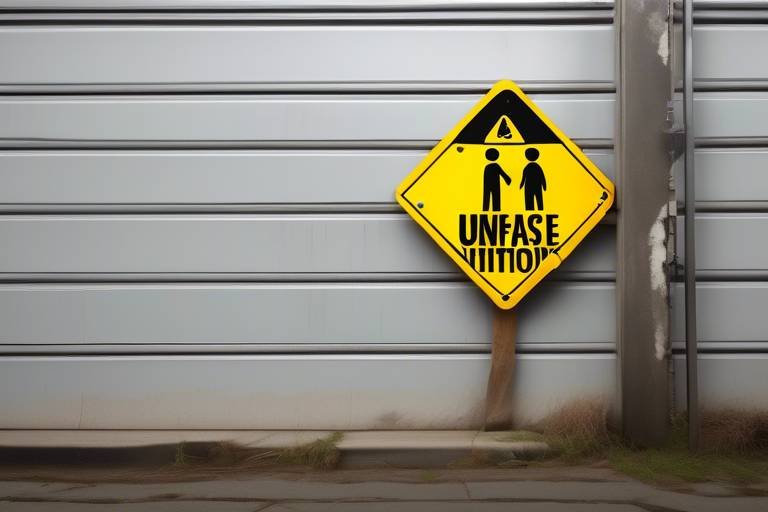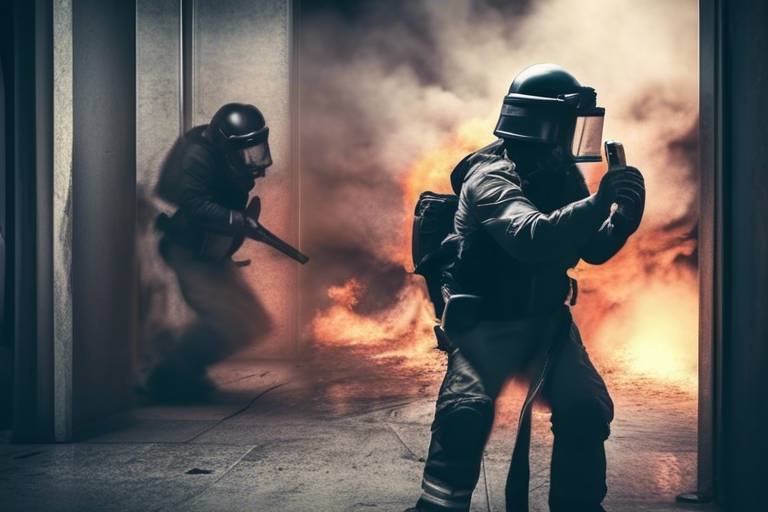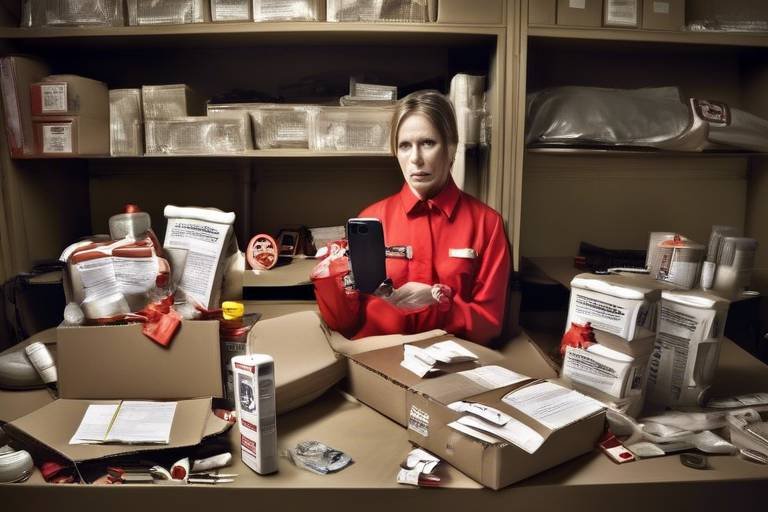Safety Habits to Cultivate in Your Daily Routine
In our fast-paced world, cultivating safety habits is not just a luxury; it's a necessity. Imagine walking through your home, your workplace, or even on the road without a care in the world, only to be caught off guard by an accident or mishap. That’s a scenario none of us want to face! By integrating essential safety practices into our daily lives, we can significantly reduce risks and enhance our well-being. So, what are these safety habits that can be seamlessly woven into our routines? Let’s dive into the various aspects of safety that can protect you and your loved ones.
Implementing safety measures at home is crucial. Your home should be a sanctuary, a place where you feel safe and secure. One of the simplest yet most effective practices is regularly checking your smoke detectors. These little devices can be lifesavers, alerting you to potential fires before they escalate. It’s recommended to test them monthly and replace batteries at least once a year. Additionally, ensure that hazardous materials, such as cleaning supplies and medications, are stored securely away from children and pets. This not only prevents accidents but also fosters a sense of responsibility in younger family members.
Understanding workplace safety is vital for preventing accidents. Whether you're working from home or in a bustling office, having an ergonomic setup can make a world of difference. Think of your body as a finely tuned machine; if the parts aren’t aligned properly, it can lead to long-term damage. Adjust your chair, desk, and computer screen to promote good posture. Moreover, using personal protective equipment (PPE) when required is essential. This could range from hard hats on construction sites to gloves in laboratories. Your safety is paramount, and taking these precautions is a step toward a secure work atmosphere.
Road safety is paramount for drivers and pedestrians alike. Ever been in a rush and thought, “I can skip the seatbelt this one time”? That’s a dangerous mindset! Wearing a seatbelt can significantly reduce the risk of injury in an accident. Always adhere to traffic laws, as they are designed to protect everyone on the road. Remain vigilant, watch for pedestrians, and avoid distractions like your phone. Remember, driving is a responsibility, not just a convenience.
Being prepared for emergencies can save lives. It’s like having an umbrella on a cloudy day—you may not need it, but when the rain comes, you’ll be glad you have it. Create an effective emergency plan by outlining evacuation routes and assembling an emergency contact list. Ensure that all family members know what to do in case of fire, earthquake, or any other unforeseen events. Regularly review these plans; practice makes perfect!
Personal hygiene plays a significant role in health safety. In the wake of the pandemic, we’ve all learned the importance of regular handwashing and sanitizing. It’s a simple act that can prevent the spread of germs and viruses. Make it a habit to wash your hands after coming home, before meals, and after using the restroom. This small change can have a big impact on your overall well-being.
In today's digital age, cybersecurity is essential. Protecting your personal information online is as crucial as locking your front door. Use strong, unique passwords for different accounts and change them regularly. Be cautious of phishing attempts; if something seems too good to be true, it probably is! Regularly updating your software can also shield you from potential threats.
Maintaining physical and mental health is key to safety. Just like a car needs regular maintenance, so do we! Regular exercise not only keeps your body fit but also boosts your mood. Think of it as a natural stress reliever. Incorporating mindfulness techniques, such as meditation or yoga, can enhance your mental resilience. These practices help you stay grounded, making it easier to handle life's challenges.
Educating children about safety is crucial. Kids are naturally curious, which can sometimes lead them into dangerous situations. Teach them about personal safety and encourage them to recognize potentially harmful scenarios. Role-playing different situations can be an engaging way to instill these important lessons. Remember, the more informed they are, the safer they will be.
Engaging in community safety efforts can enhance overall security. Participating in local programs not only fosters a sense of belonging but also contributes to a safer environment for everyone. Whether it's neighborhood watch groups or community clean-ups, every little effort counts. Together, we can create a culture of safety that benefits all.
Q1: How often should I check my smoke detectors?
A1: It’s recommended to test your smoke detectors monthly and replace the batteries at least once a year.
Q2: What are some basic personal hygiene practices I should follow?
A2: Regular handwashing, sanitizing surfaces, and maintaining dental hygiene are essential practices for good health.
Q3: How can I teach my child about safety?
A3: Use role-playing scenarios to teach them about personal safety and encourage open discussions about safety concerns.
Q4: Why is cybersecurity important?
A4: With increasing digital threats, safeguarding your personal information is crucial to prevent identity theft and fraud.

Home Safety Practices
Implementing safety measures at home is crucial for ensuring the well-being of you and your loved ones. Think of your home as a fortress; it should be a place where you feel secure and protected from potential hazards. One of the simplest yet most effective practices is to regularly check your smoke detectors. Did you know that a working smoke detector can reduce the risk of dying in a fire by nearly half? It's true! Make it a habit to test your smoke detectors monthly and replace the batteries at least once a year. You can even mark your calendar to remind yourself; after all, out of sight shouldn’t mean out of mind.
Another essential practice is the secure storage of hazardous materials. Items such as cleaning supplies, medications, and tools can pose significant risks if not stored properly. Consider using childproof locks on cabinets where these items are kept, especially if you have little ones running around. Not only does this protect children, but it also keeps pets safe from accidental ingestion. Taking a few moments to organize and secure these materials can prevent accidents that could lead to serious injuries.
Moreover, establishing a fire escape plan is vital. In the event of a fire, every second counts. Sit down with your family and map out a clear escape route from each room in your house. Make sure everyone knows at least two ways to exit. Practice this plan regularly, just as you would a fire drill at school. It’s not just about knowing what to do; it’s about being prepared and confident when the time comes.
Don’t forget about the importance of lighting in your home. Proper lighting can significantly reduce the risk of accidents. Make sure hallways, staircases, and entrances are well-lit. If you have outdoor spaces, consider installing motion-sensor lights to deter intruders and provide visibility during the night. A well-lit environment is not only safer but also more welcoming.
Lastly, consider the benefits of a home security system. While it might seem like an unnecessary expense, the peace of mind it provides can be invaluable. Many modern systems come equipped with surveillance cameras, alarms, and even mobile alerts, allowing you to monitor your home from anywhere. This is especially important if you travel frequently or have extended periods away from home. Investing in your home’s security is investing in your family's safety.
In summary, cultivating home safety practices is about being proactive rather than reactive. By regularly checking smoke detectors, securely storing hazardous materials, establishing a fire escape plan, ensuring proper lighting, and considering a home security system, you can create a safer living environment for everyone. It’s all about making small changes that lead to a big impact!
Q: How often should I check my smoke detectors?
A: It's recommended to test your smoke detectors monthly and replace the batteries at least once a year.
Q: What should I do if my smoke detector goes off?
A: Evacuate the premises immediately, call emergency services, and do not re-enter until it is deemed safe.
Q: How can I childproof my home effectively?
A: Use childproof locks for cabinets, store hazardous materials out of reach, and keep sharp objects secured.
Q: What are some tips for creating a fire escape plan?
A: Designate two exits from each room, establish a meeting point outside, and practice the plan regularly with your family.

Workplace Safety Guidelines
Understanding workplace safety is not just a box to check off; it’s a fundamental aspect of fostering a healthy and productive environment. Imagine walking into an office where every corner is designed with safety in mind—where the air feels lighter because everyone is aware and prepared. This isn't just a dream; it's achievable through the cultivation of effective safety habits. One of the first steps to ensure safety at work is to create an ergonomic workspace. This means adjusting your chair, desk, and computer setup to fit your body, reducing the risk of strain or injury. For instance, your monitor should be at eye level, and your chair should support your lower back. By investing a little time in these adjustments, you’re not just enhancing comfort; you’re actively preventing long-term health issues.
Another crucial component of workplace safety is the proper use of personal protective equipment (PPE). Whether you work in a factory, a lab, or even an office, understanding what PPE is necessary for your specific environment can be a game-changer. For example, if you're in a construction zone, wearing a hard hat and steel-toed boots isn’t just recommended; it’s essential. Yet, it’s not only about wearing the gear; it’s about knowing how to use it effectively. Training sessions can be invaluable, ensuring that everyone knows when and how to use their protective equipment. This proactive approach can dramatically reduce workplace accidents.
Moreover, regular safety drills should be a part of your workplace culture. Think of these drills as fire drills for your mind—preparing you for the unexpected. Whether it's a fire, an earthquake, or even a medical emergency, knowing what to do can save lives. Conducting these drills not only familiarizes employees with safety protocols but also fosters a sense of community and teamwork. When everyone knows their role in an emergency, the workplace becomes a safer, more cohesive unit.
Communication plays a pivotal role in workplace safety as well. Encouraging open dialogue about safety concerns can lead to proactive measures that prevent accidents before they happen. Create a culture where employees feel comfortable reporting hazards without fear of reprisal. This can be as simple as having a suggestion box or regular safety meetings where everyone can voice their thoughts. The more aware everyone is of potential risks, the safer the workplace becomes.
In addition, it's essential to stay updated with safety regulations and guidelines. Laws and safety standards can change, and being informed can make all the difference. Regular training sessions that include updates on new safety protocols not only keep everyone informed but also demonstrate a commitment to employee well-being. Companies can even create a Safety Manual that outlines all procedures, making it easily accessible for everyone. This manual can serve as a reference guide, ensuring that safety remains a priority.
Lastly, consider implementing a safety rewards program. Recognizing and rewarding employees who actively participate in safety initiatives can motivate others to follow suit. Whether it’s a simple acknowledgment in a meeting or a more formal reward system, celebrating safety can create a positive atmosphere where everyone feels responsible for their own safety and that of their colleagues.
Q: What is the most important aspect of workplace safety?
A: While all aspects are important, having a culture of open communication about safety concerns is crucial. It encourages employees to speak up and take proactive steps to mitigate risks.
Q: How often should safety drills be conducted?
A: Safety drills should be conducted at least twice a year, but more frequent drills can help keep safety protocols fresh in everyone’s mind.
Q: What should I do if I notice a safety hazard at work?
A: Report it immediately to your supervisor or the safety officer. It’s important to address hazards as soon as they are identified to prevent accidents.
Q: Are there specific laws governing workplace safety?
A: Yes, various laws and regulations exist, such as OSHA (Occupational Safety and Health Administration) standards in the United States, which outline specific safety requirements for different industries.

Road Safety Awareness
Road safety is not just a set of rules; it’s a vital part of our daily lives that affects everyone—drivers, pedestrians, cyclists, and even passengers. Imagine stepping outside your home, ready to conquer the day, but then encountering a chaotic intersection where traffic laws seem to vanish. Scary, right? That’s why fostering an awareness of road safety is essential to prevent accidents and save lives. It’s about creating a culture where everyone feels responsible for their own safety and the safety of others on the road.
First and foremost, understanding the importance of traffic laws is crucial. These laws are designed to regulate traffic flow and ensure that everyone gets to their destination safely. Whether it’s stopping at red lights, yielding to pedestrians, or obeying speed limits, adhering to these rules can significantly reduce the risk of accidents. Think of traffic laws as the lifeline of road safety—when we follow them, we’re contributing to a safer community.
Another key aspect is the simple act of wearing seatbelts. It’s astonishing how many lives are saved each year just by buckling up. According to statistics, wearing a seatbelt reduces the risk of fatal injury by 45% for front-seat passengers. So, whether you’re driving or riding, make it a habit to fasten your seatbelt. It’s a small action that can have a monumental impact on your safety.
Staying vigilant is equally important. Distracted driving has become a leading cause of accidents. Just think about it: how often do you see someone texting while driving? It’s alarming! To combat this, it’s essential to keep your focus on the road. Here are a few tips to help maintain your concentration:
- Put your phone on silent or use hands-free devices.
- Avoid eating or drinking while driving.
- Limit conversations with passengers if you’re feeling distracted.
Moreover, being aware of your surroundings can save lives. This means not only looking out for other vehicles but also being mindful of pedestrians and cyclists. Always check your mirrors and blind spots before changing lanes or making turns. Remember, you’re not just responsible for your own safety but also for those around you.
In addition to these practices, it’s essential to understand the role of weather conditions in road safety. Rain, snow, and fog can drastically alter driving conditions. When the weather turns, it’s time to adjust your driving style. Slow down, increase your following distance, and use your headlights to improve visibility. Just like a ship navigating through a storm, a cautious driver can steer clear of disaster.
Lastly, let’s not forget about the importance of educating others, especially young drivers. Sharing knowledge about road safety can be incredibly impactful. Consider organizing community workshops or school programs that focus on safe driving practices. The more we talk about it, the more awareness we create, and the safer our roads become.
In summary, road safety awareness is a multifaceted issue that requires the participation of everyone. By following traffic laws, wearing seatbelts, staying vigilant, adapting to weather conditions, and educating others, we can create a safer road environment for all. Remember, safety is not just a habit; it’s a lifestyle!
1. What should I do if I see a reckless driver?
If you encounter a reckless driver, maintain a safe distance and avoid engaging with them. If necessary, report their behavior to local authorities.
2. How can I teach my children about road safety?
You can teach children about road safety by setting a good example, discussing traffic signs, and practicing safe crossing techniques together.
3. What are the consequences of not wearing a seatbelt?
Not wearing a seatbelt can lead to severe injuries or fatalities in the event of an accident, as well as potential legal penalties depending on local laws.
4. How often should I check my vehicle for safety?
Regular maintenance checks should be done monthly, including tire pressure, brakes, and lights, to ensure your vehicle is safe to drive.

Emergency Preparedness Plans
When it comes to emergencies, being prepared can mean the difference between chaos and calm. Imagine facing a natural disaster or sudden crisis without a plan—it's like navigating a stormy sea without a compass. That's why having a solid emergency preparedness plan is essential for every household. It not only equips you with the knowledge to respond effectively but also provides peace of mind knowing that you are ready for the unexpected.
First and foremost, it's important to identify the types of emergencies that could potentially affect your area. This could range from natural disasters like hurricanes and earthquakes to man-made situations such as fires or power outages. Once you've identified these risks, you can tailor your emergency plan accordingly. For instance, if you live in a flood-prone area, knowing your evacuation routes and having a go-bag ready can significantly increase your safety.
Next, consider creating a detailed emergency plan that includes the following key components:
- Evacuation Routes: Map out multiple routes to safety, ensuring that everyone in your household knows them. Practice these routes regularly so that they become second nature.
- Emergency Contact List: Compile a list of important contacts, including family members, neighbors, and local emergency services. Keep this list in a visible place and ensure that everyone knows how to access it.
- Communication Plan: In the event of an emergency, communication can be challenging. Establish a plan for how your family will stay in touch, whether through text, social media, or designated meeting spots.
Don't forget to prepare an emergency kit that includes essential supplies. Think of this kit as your lifeline during a crisis. It should contain items like non-perishable food, water, a flashlight, batteries, and first-aid supplies. Make sure to check and replenish your kit regularly, especially if you have perishable items.
Finally, conduct regular drills with your family to ensure that everyone understands the plan. These drills serve as a practical rehearsal, helping to reduce panic and confusion during real emergencies. Just like a fire drill at school, practicing these scenarios can empower everyone to act swiftly and efficiently when it counts the most.
In conclusion, being prepared for emergencies is not just about having a plan; it's about fostering a culture of safety within your home. By taking the time to develop and practice your emergency preparedness plan, you're not only protecting yourself and your loved ones but also contributing to a safer community. Remember, in the face of uncertainty, knowledge and preparation are your greatest allies.
Q1: How often should I review my emergency plan?
A1: It's a good idea to review your emergency plan at least once a year or whenever there are significant changes in your household, such as moving to a new location or adding a family member.
Q2: What should I include in my emergency kit?
A2: Your emergency kit should include water, non-perishable food, a flashlight, batteries, a first-aid kit, personal hygiene items, and any necessary medications. Don't forget to include important documents in a waterproof bag.
Q3: How can I ensure my children understand the emergency plan?
A3: Involve your children in creating the plan and practice it together. Use simple language and make it fun, perhaps by turning it into a game or a family activity.

Personal Hygiene and Safety
In our fast-paced world, the importance of personal hygiene cannot be overstated. It’s not just about looking good or feeling fresh; it’s a crucial part of maintaining our health and safety. Think of personal hygiene as the first line of defense against various illnesses and infections. Just like a knight wears armor to protect against enemies, we can arm ourselves with good hygiene practices to fend off germs and bacteria that threaten our well-being.
One of the simplest yet most effective habits is regular handwashing. Imagine shaking hands with a friend only to find out later that they had just touched a doorknob covered in germs. Yikes! Washing your hands with soap and water for at least 20 seconds can significantly reduce the risk of spreading infections. It’s like washing away those invisible foes that want to invade your health. According to health experts, handwashing can cut the risk of respiratory infections by up to 21% and gastrointestinal diseases by 31%. That's a powerful statistic!
Another essential aspect of personal hygiene is maintaining oral health. Brushing your teeth twice a day and flossing regularly is not just about having a bright smile; it also prevents gum disease and tooth decay, which can lead to more serious health issues. In fact, poor oral hygiene has been linked to heart disease and diabetes. So, the next time you pick up your toothbrush, remember that you’re not just cleaning your teeth; you’re also safeguarding your overall health.
Additionally, paying attention to personal grooming is vital. This includes regular showers, wearing clean clothes, and taking care of your nails and hair. These practices not only enhance your appearance but also contribute to your mental well-being. Feeling clean and well-groomed can boost your confidence and improve your mood. It’s like putting on your favorite outfit before heading out; it makes you feel ready to conquer the world!
It’s also important to consider the products we use in our daily hygiene routines. Opting for natural and safe products can help reduce exposure to harmful chemicals. For instance, using organic soaps and shampoos can minimize skin irritations and allergies. Always check the labels and be mindful of the ingredients you are applying to your skin. Remember, your skin is your largest organ, and what you put on it matters!
In addition to these practices, maintaining a healthy diet and staying hydrated plays a role in personal hygiene. Eating a balanced diet rich in fruits, vegetables, and whole grains can boost your immune system, making it easier for your body to fight off infections. Staying hydrated helps your body function optimally, flushing out toxins and keeping your skin healthy. It’s like giving your body the fuel it needs to operate at its best!
Lastly, let’s not forget about the importance of mental health in the realm of personal hygiene. Stress and anxiety can lead to neglecting our hygiene practices. Taking time for self-care, whether through meditation, exercise, or simply enjoying a hobby, can help maintain a healthy mind, which in turn encourages good hygiene habits. After all, a happy mind often leads to a healthy body!
In summary, cultivating good personal hygiene habits is essential for safety and well-being. By incorporating simple practices into your daily routine, you can build a strong defense against illnesses and enhance your overall quality of life. Remember, hygiene is not just a chore; it’s a lifestyle choice that pays off in the long run!
- How often should I wash my hands? It’s recommended to wash your hands before meals, after using the restroom, and after coming home from public places.
- What are the signs of poor personal hygiene? Signs include body odor, bad breath, and visible dirt on the skin or clothing.
- Can personal hygiene impact mental health? Yes, maintaining good hygiene can improve self-esteem and reduce feelings of anxiety or depression.
- What are some natural products I can use for personal hygiene? Look for organic soaps, natural deodorants, and chemical-free shampoos available in local health stores.

Cybersecurity Measures
In an age where our lives are increasingly intertwined with technology, cybersecurity has become a critical aspect of our daily routines. Think of your personal data as a treasure chest; you wouldn’t leave it unlocked for anyone to rummage through, would you? Just like that, you need to safeguard your digital assets from prying eyes and malicious attacks. One of the first steps in fortifying your online presence is to use strong passwords. A strong password is like a solid lock on your door—it's the first line of defense against intruders.
But what makes a password strong? It should be a mix of uppercase and lowercase letters, numbers, and special characters. For instance, instead of using “Password123,” opt for something like “P@ssw0rd!2023.” It’s quirky, hard to guess, and provides better security. And remember, using the same password across multiple accounts is like using the same key for your house, car, and safe—if someone gets that key, they have access to everything! To combat this, consider using a password manager. These tools can generate and store complex passwords for you, ensuring that each account has a unique and secure password.
Another essential measure is to be aware of phishing attempts. Phishing is a tactic used by cybercriminals to trick you into revealing sensitive information, like your passwords or credit card numbers. They often disguise themselves as trustworthy entities, sending emails that appear legitimate. Always scrutinize emails, especially those requesting personal information or urging immediate action. If something feels off, it probably is. Hover over links before clicking to see where they lead—this simple step can save you from falling into a trap.
Moreover, keeping your software and devices updated is crucial. Software developers frequently release updates that patch security vulnerabilities, making it harder for hackers to exploit weaknesses. So, when you see that notification for an update, don’t hit snooze! Embrace it. It’s like getting your home inspected for potential hazards; it’s a proactive way to maintain safety.
Lastly, consider enabling two-factor authentication (2FA) wherever possible. This extra layer of security requires not just your password but also a second form of verification, such as a text message or an authentication app code. It’s like having a security guard at your door who checks your ID before letting you in. Even if someone gets hold of your password, they’ll still need that second factor to gain access.
To summarize, here are some key cybersecurity measures you should implement:
- Create strong, unique passwords for each account.
- Be vigilant against phishing attempts and verify the source of communications.
- Keep your software updated to protect against vulnerabilities.
- Enable two-factor authentication for an added layer of security.
By incorporating these practices into your daily routine, you can significantly reduce your risk of falling victim to cyber threats. Remember, in the digital world, being proactive is your best defense. Stay safe out there!
Q: What is the most important cybersecurity measure I should take?
A: Using strong, unique passwords for each of your accounts is a fundamental step in protecting your online presence.
Q: How can I recognize a phishing email?
A: Look for signs such as poor grammar, generic greetings, and suspicious links. Always verify the sender's email address.
Q: What should I do if I think I've been hacked?
A: Change your passwords immediately, enable two-factor authentication, and monitor your accounts for any suspicious activity.

Health and Wellness Practices
When it comes to health and wellness, the importance of cultivating good habits cannot be overstated. Think of your body as a finely-tuned machine; if you neglect the maintenance, it simply won’t run as efficiently. So, how can you ensure that your machine is operating at peak performance? The answer lies in a combination of physical activity, mental well-being, and proper nutrition. Each of these elements plays a crucial role in not just surviving, but thriving in your daily life.
First off, let’s talk about regular exercise. It’s not just about hitting the gym for an hour; it’s about incorporating movement into your daily routine. Whether it’s a brisk walk, a dance class, or even gardening, staying active helps keep your heart healthy, improves your mood, and boosts your energy levels. The key is to find activities that you enjoy so that staying active feels less like a chore and more like a fun part of your day. Aim for at least 150 minutes of moderate aerobic activity each week, and don’t forget to include strength training exercises at least twice a week.
Now, let’s not overlook the power of mindfulness techniques. In our fast-paced world, it’s easy to get caught up in the hustle and bustle, leaving little room for mental clarity. Practicing mindfulness can be as simple as taking a few moments each day to focus on your breathing or engaging in meditation. These practices can significantly reduce stress, enhance focus, and improve emotional resilience. Just think of it as a mental reset button that you can press whenever life gets overwhelming.
Nutrition is another cornerstone of health and wellness. What you put into your body directly affects how you feel and function. A balanced diet rich in fruits, vegetables, whole grains, and lean proteins can work wonders for your overall health. Consider keeping a food diary to track your eating habits; this will help you identify areas for improvement. And remember, hydration is crucial! Drinking enough water throughout the day can help maintain your energy levels and promote better cognitive function.
To help you visualize the balance of nutrients, here’s a simple
| Nutrient | Recommended Proportion |
|---|---|
| Fruits and Vegetables | 50% |
| Whole Grains | 25% |
| Proteins | 25% |
Lastly, let’s not forget about social connections. Engaging with friends and family can boost your mental health and provide a support system during tough times. Make it a point to reach out to loved ones regularly, whether through phone calls, video chats, or in-person meetups. Building strong relationships can serve as a buffer against stress and promote a sense of belonging.
In summary, cultivating health and wellness practices in your daily routine is not just beneficial; it’s essential. By incorporating regular physical activity, mindfulness, balanced nutrition, and strong social connections, you’re setting yourself up for a happier, healthier life. So, what are you waiting for? Start making small changes today, and watch as they transform your overall well-being!
- What are some easy exercises I can do at home? Simple exercises like squats, push-ups, and yoga can be done anywhere and require minimal equipment.
- How can I practice mindfulness? Start with just five minutes a day of focused breathing or guided meditation apps that can help you get started.
- What should I eat for a balanced diet? Aim for a colorful plate filled with a variety of fruits and vegetables, whole grains, and lean proteins.
- How can I stay motivated to exercise? Find a workout buddy, set achievable goals, and choose activities you love to keep your motivation high.

Child Safety Awareness
When it comes to child safety, awareness is the first step toward prevention. Children are naturally curious, and their inquisitive nature can sometimes lead them into dangerous situations. As parents, guardians, or educators, it’s our responsibility to equip them with the knowledge and skills they need to navigate the world safely. But how can we effectively teach kids about safety without overwhelming them? It's all about creating a fun and engaging learning environment.
Start by having open conversations with children about safety. Use relatable scenarios that they might encounter in their daily lives. For example, you could discuss the importance of stranger danger by role-playing different situations. Ask questions like, "What would you do if someone you don't know asks you to come with them?" This not only makes the conversation interactive but also helps them think critically about their responses.
Additionally, consider integrating safety education into everyday activities. For instance, while walking to school, point out safe crossing spots and explain why it’s important to look both ways before crossing the street. This practical approach reinforces lessons in a real-world context, making the information more memorable.
Here are some key areas to focus on when discussing child safety:
- Personal Safety: Teach children how to recognize unsafe situations, such as being approached by strangers or entering a home without permission.
- Road Safety: Instill the importance of using crosswalks, obeying traffic signals, and wearing helmets while biking.
- Home Safety: Discuss the dangers of household items like sharp objects, chemicals, and hot surfaces. Encourage them to always ask an adult before using anything that could be harmful.
Moreover, it's crucial to establish clear rules and guidelines. For example, set boundaries about where they can play and with whom. Explain why these rules are in place, as understanding the reasoning behind them can help children feel more secure. You could create a simple child safety plan that includes emergency contact numbers, safe places to go in case of danger, and a list of trusted adults they can turn to for help.
Lastly, don’t forget the power of community. Engaging with local safety programs or workshops can enhance your child's understanding of safety in a broader context. Many communities offer resources for families, such as safety fairs or educational sessions, which can be both informative and enjoyable. Remember, the goal is to empower children with knowledge while ensuring they feel safe and supported.
Q: How can I make safety discussions less intimidating for my child?
A: Use playful language and scenarios. Role-playing can make these discussions feel like a game rather than a lecture.
Q: What age should I start teaching my child about safety?
A: It's never too early to start. Begin with basic concepts like "stranger danger" around age 3 and build from there as they grow.
Q: Are there any resources for teaching child safety?
A: Yes! Look for local workshops, online resources, or children's books that focus on safety topics.

Community Safety Initiatives
Engaging in is not just a noble endeavor; it's a vital part of creating a secure environment for everyone. When we come together as a community, we can address safety concerns more effectively than we could as individuals. Imagine a neighborhood where everyone looks out for one another—sounds like a scene from a feel-good movie, right? But it can be a reality! By participating in local programs, we can foster a sense of belonging and responsibility that enhances the safety of our surroundings.
One of the most impactful ways to engage in community safety is through the formation of neighborhood watch programs. These programs encourage residents to keep an eye on each other's properties and report any suspicious activities. It's like having a built-in security system made up of vigilant neighbors. Not only does this deter crime, but it also builds trust among community members. When people know their neighbors are looking out for them, it creates a safer and more welcoming atmosphere.
Additionally, local governments often organize safety workshops and training sessions. These events can cover a range of topics, from basic first aid to emergency preparedness. Participating in these workshops equips residents with the knowledge and skills they need to respond effectively in crisis situations. For instance, knowing how to perform CPR can be a lifesaver, literally! By encouraging community members to attend these sessions, we can collectively boost our preparedness and resilience.
Another aspect of community safety is the importance of open communication. Establishing channels for residents to report safety concerns or share valuable information can significantly enhance community safety. This can be done through social media groups, community forums, or even a simple neighborhood newsletter. When everyone is informed and engaged, it creates a culture of safety where people feel empowered to take action.
Moreover, communities can collaborate with local law enforcement to address specific safety issues. Regular meetings with police officers can provide residents with insights into crime trends and prevention strategies. This partnership can lead to initiatives like safety audits, where law enforcement and community members work together to identify and mitigate potential hazards. It's all about teamwork!
Lastly, don't underestimate the power of community events. Organizing block parties, clean-up days, or safety fairs can bring people together and promote a sense of unity. These gatherings not only strengthen community bonds but also serve as platforms to discuss safety issues and share resources. After all, when people feel connected, they are more likely to look out for one another.
In conclusion, community safety initiatives are essential for fostering a secure environment. By participating in neighborhood watch programs, attending safety workshops, facilitating open communication, collaborating with law enforcement, and organizing community events, we can create a culture of safety that benefits everyone. So, the next time you hear about a community safety initiative, consider getting involved. Together, we can make our neighborhoods safer, one initiative at a time!
Q: How can I start a neighborhood watch program?
A: To start a neighborhood watch program, gather interested neighbors and contact your local law enforcement agency for guidance. They can provide resources and support to help you establish the program effectively.
Q: What should I do if I notice suspicious activity in my neighborhood?
A: If you notice suspicious activity, report it to your local police department immediately. It's better to be cautious and report something that may seem minor than to overlook a potential threat.
Q: How can I encourage my neighbors to participate in community safety initiatives?
A: You can encourage participation by sharing information about upcoming events, discussing the benefits of community safety initiatives, and emphasizing the importance of working together to create a safer environment.
Q: Are there any costs associated with community safety initiatives?
A: Many community safety initiatives are free or low-cost. However, some workshops or training sessions may have a small fee. It's best to check with local organizations for specific details.
Frequently Asked Questions
- What are some essential home safety practices?
To ensure a safe living environment, regularly check smoke detectors, keep hazardous materials securely stored, and maintain clear pathways to prevent accidents. These simple habits can make a significant difference in your home's safety.
- How can I improve workplace safety?
Improving workplace safety involves understanding ergonomic setups, using personal protective equipment correctly, and fostering a culture of safety among colleagues. Regular training sessions can also help keep everyone informed and vigilant.
- What should I do to stay safe on the road?
Staying safe on the road requires following traffic laws, wearing seatbelts, and staying alert. Being aware of your surroundings and avoiding distractions, like using your phone while driving, can significantly reduce the risk of accidents.
- How can I prepare for emergencies?
Creating an effective emergency preparedness plan includes outlining evacuation routes, compiling a list of emergency contacts, and regularly practicing drills with your family. This ensures that everyone knows what to do in unexpected situations.
- Why is personal hygiene important for safety?
Maintaining personal hygiene, such as regular handwashing and sanitizing, is crucial for preventing the spread of germs. Good hygiene practices not only protect your health but also contribute to the well-being of those around you.
- What cybersecurity measures should I take?
To protect your personal information online, use strong, unique passwords for different accounts, enable two-factor authentication, and be cautious of phishing attempts. Staying informed about the latest cybersecurity threats can also help you stay one step ahead.
- How can I maintain my health and wellness?
Regular exercise, a balanced diet, and mindfulness techniques are essential for maintaining both physical and mental health. Incorporating these habits into your daily routine can significantly enhance your overall well-being and resilience.
- What strategies can I use to teach children about safety?
Teaching children about safety involves engaging them in discussions about recognizing dangerous situations, practicing safe behaviors, and encouraging open communication. Role-playing scenarios can help reinforce these lessons in a fun and memorable way.
- How can I get involved in community safety initiatives?
Participating in local safety programs and initiatives is a great way to enhance security in your community. You can volunteer for neighborhood watch programs, attend safety workshops, or collaborate with local organizations to promote a safer environment for everyone.



















